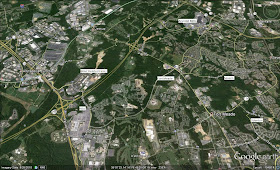In order to achieve this growth for the City, Anne Arundel County needs additional Rail Transit. One might say that plenty of lines already run through Anne Arundel County. Although this is true, there are plenty of ways to expand and enhance existing lines using the Baltimore Regional Rail Plan as a guide.
No conversation about planning Rail Lines should be
complete without discussing the Yellow Line. Often times I feel like I'm
its lone supporter but I happen to find it crucial in supporting growth
in Baltimore, Towson, Columbia and all points in between.
(picture of Penn Station)
Right now the Yellow Line exits in its infancy as the spurs of the Central Light Rail Line from BWI to Penn Station sharing most of its route with the Central Light Rail Line. A lot of these proposed in between points are in Anne Arundel County. Currently, the "Yellow Line" ends at BWI Airport. At the very least it needs to be extended to the Amtrak/MARC Station at BWI roughly a mile away. This new stop will connect the Yellow Line with the MARC Penn Line as well as the Amtrak Line just one stop away from Penn Station. After this very important stop the Yellow Line should continue to the Baltimore Commons Business Park. This is located just north of Arundel Mills Mall, a VERY high growth area of Anne Arundel County.
The Baltimore Commons
area is experiencing plenty of growth of its own with more to come.
After that, the Yellow Line will continue south for a stop at the sprawl
ridden Arundel Mills Mall and Maryland Live Casino.
This area has
exploded from a rural Glen Burnie suburb to a bustling and congested
shopping mecca. People come from all around the Baltimore Metropolitan
Area to shop and gamble here so having a Rail Transit stop here is
crucial to relieve traffic congestion. The Baltimore Regional Rail Plan
calls for the Yellow Line to stop at the Dorsey MARC Station/MTA Orange
Line before entering Howard County.
Personally, I think there's
another station that needs to see more activity on the MARC Camden Line
and that station is Jessup. Jessup is located just north of all the BRAC
related growth although that can be serviced by the Savage Station. It
is however located directly east of intense residential growth in
Elkirdge.
Route 1 has become very congested
with TOD style high density housing but the Rail Transit that warrants
this type of development isn't here yet. With that in mind I have
decided to put the Yellow Line Stop at Jessup and make that stop into a
full fledged station that can hold more than a dozen vehicles. After
Jessup, the Yellow Line will go into Howard County ultimately ending at
Columbia Town Center. I will write a post that's dedicated to the Yellow
Line in Howard County at a later date.
Now we come to the Central
Light Rail Line or the Blue Line as it's also known. According to the
Baltimore Regional Rail Plan, this line is complete. After all, it goes
all the way from Cromwell Station to Hunt Valley! That's pretty long
don't you think? Well, yes that is long but I believe it can go even
further into Anne Arundel County.
Southeast of Cromwell
Station lies Glen Burnie Town Center, this early attempt at mixed use
development in Glen Burnie is literally at the center of Town straddling
the intersection of Baltimore Annapolis Boulevard and Crain Highway. In
addition to Retail there's a small residential component along with a
branch of Anne Arundel Community College and a Parking Garage. This
heavily traveled corridor is the perfect location for a new Light Rail
Station.
After Glen Burnie Town Center, the Blue Line will travel under Ritchie Highway.
It will have stops at Marley Station, Pasadena, Severna Park, Anne Arundel Community College, and Arnold.
One will end at Annapolis Mall while the other will end at Downtown Annapolis. Annapolis should be the ultimate destination of the Blue Line. Annapolis to Hunt Valley imagine the traffic relief with a line that long.
Now we come to the Purple Line, which is actually a
localized MARC Penn Line. Non MARC Stops include Sandtown, Fredrick
Avenue, Rosedale, Rossville in Baltimore City and County. This line will
meet the extended Yellow Line at the BWI Amtrak/MARC Station. While in
Anne Arundel County this line runs roughly parallel to Telegraph Road.
Telegraph Road runs right through Severn, a mostly residential town that
is right in between Arundel Mills and Fort Meade. Needless to say,
given Severn's location, it has seen unprecedented growth with more
surely to come.
Reece Road at Old Meade Camp Road is my
proposed location for a "Non MARC" Severn Station. This station would be
smaller in comparison to say that of Arundel Mills because Severn is so
residential. That being said, Residents living off of Telegraph Road,
Reece Road, New Disney Road, Harmans Road, and Severn Road would be very
well served by having a Rail Stop so close to home.
The end of the Purple Line's jurisdiction
will be at the Odenton MARC Station. Odenton has also experienced major
growth over the last 20 years with the construction of Piney Orchard and
now the development of a Town Center. The existing MARC Station is
strategically located right in between the two new developments and
right where Town Center Boulevard is slated to meet Route 175.
Given how much growth Anne Arundel County
is experiencing, it's only right that the Baltimore Regional Rail Plan
update itself to reflect this growth. Rail Transit only succeeds when
there are stops at all or almost all populated places. If only highway
expansion project funds were diverted into Mass Transit.

























































